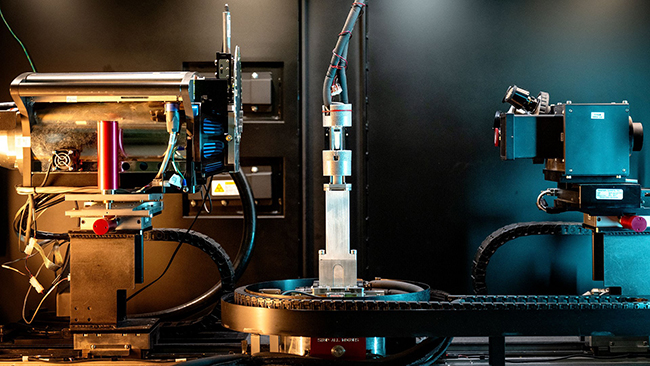Text: Miriam Meister, DTU Dynamo - 73, June 2023.
Even though Italians have produced mozzarella for centuries, food scientists still try to understand exactly which properties give the cheese optimal stretchiness when baked. Mozzarella—unlike most other cheeses—is kneaded during production giving it a stringy consistency, but how precisely this unique structure correlates to its baking properties is still a bit of a mystery.
PhD student Pawel Pieta from DTU is on a mission to find the exact microstructure of the hard-to-scan cheese. He uses CT-scans to produce 3D-images of it. His work is part of an Innovation Fund Denmark-funded research project that is headed by Scandinavian dairy producer Arla.
Ultimately, the aim is to correlate information about the structure of a sample with its functional properties. Connecting the dots between a well-performing batch of mozzarella and its composition is key to determining the perfect recipe and thus consistently produce the desired quality.
Tackling technical challenges
Anyone who has had a CT-scan at a hospital knows that it takes only a few minutes. This is due to the density of our bones, which makes them good at stopping the X-rays beamed at them.
“Proteins and fats—which mozzarella consists of—hardly stop X-rays at all. So, to not only register that there is actually a cheese here but also capture the structure inside, we have to take very long-exposure images and thousands of them to gather the information to create a 3D-image,” Pawel Pieta explains.
Hence, it has taken as long as 12 hours for the researcher to scan a 2x2x2cm block of mozzarella, which posed another challenge:
“At room temperature, cheese melts slowly. Even if it does not melt completely during the scan, it will go a bit soggy and change its shape. So, keeping the cheese at an appropriate temperature throughout the scan so it doesn’t melt has been a challenge,” he says.
The PhD student and his colleagues solved this issue by modifying a container to hold the hard-to-scan cheese, which they cooled by flushing cold ethylene glycol through the top and bottom of the container. They fitted the container with a fan to circulate the cold air.
The scans they have produced so far document that mozzarella—as expected— is anisotropic, meaning that the matter has a structure that by and large runs in the same direction. Anisotropic materials have different properties in different directions. Wood, for example, is very anisotropic which increases its tensile strength along the grain. Tensile strength is a measure of how much stress a material can withstand while being stretched before breaking. In the case of mozzarella being anisotropic makes it able to stretch more in some directions than others.

By scanning mozzarella samples measuring just 2 x 2 x 2 cm, Pawel can obtain large amounts of data about the quality of the cheese. Photo: Bax Lindhardt.
Less reliance on current test method
Work is on-going to create even better images of the directionality of the structure before correlating this information with data on how well the cheese performs. DTU has acquired a new type of CT-scanner, which is expected to slash the time it takes to scan the samples—and the resulting images are predicted to be much clearer.
After production runs, Arla currently test their mozzarella by making pizzas to check that the baked cheese has the right colour, taste and stretch. They use a machine to test the stretch, which removes human inconsistencies when doing the measurements.
The project partners expect less reliance on the stretch test by the end of the project as the new in-depth understanding will make it possible to implement early production steps that ensure the desired mozzarella.
Other areas of application
Pawel Pieta says that learnings from this project will be applicable to other types of materials, which are anisotropic in nature:
“Like the cooling chamber, many of our ideas relate to the cheese only. However, the image processing part of the work is expected to be very broad and can be applied to many different materials.”
Any fibre-based materials that have structures inside that need a closer look and characterization are potential candidates, such as blades for wind turbines, textiles, or insulation.
“If the material is made in a way that it should be able to withstand some force in one direction and not the other, 3D imaging may make us able to verify that there is anisotropy throughout this material. It can help confirm whether it was made well enough to withstand the force,” he explains.
“It would provide a deeper look. You can always do a stress test and check how much force a material will withstand, but that destroys the product. While it proves what you want to achieve, you still have no idea what is inside the material and why it does what it does. Hopefully using our method, we will be able to provide this why.”
The mozzarella has been scanned at DTU's 3D Imaging Centre, which houses state-of-the-art instruments. They can carry out scans which reveal the exterior and interior of an object at the same time - without the objects having to be cut open
At the center you scan e.g. hard materials such as minerals and metals, which i.e. are relevant in relation to CO2 storage and to building steel structures such as wind turbines. The equipment is also used to scan organs, bones and plants in search of new products for the health sector, as well as to examine natural and cultural heritage items such as fossils and museum objects.
Among the more notable tasks, the center has e.g. helped the Natural History Museum scan a Tyrannosaurus Rex skull and made a CT X-ray of the prosthetic hand used by Paralympic table tennis player Peter Rosenmeier so he could have an exact replica made.
Find out more here:
The 3D Imaging Centre, 3DIM